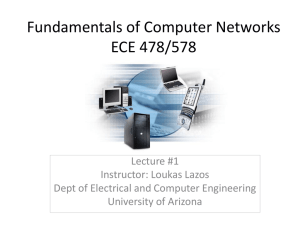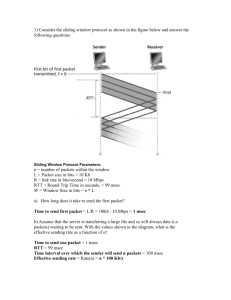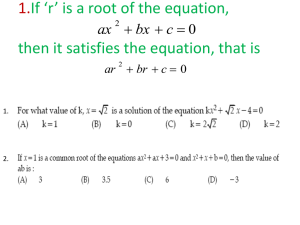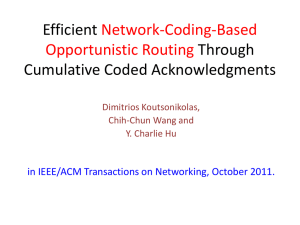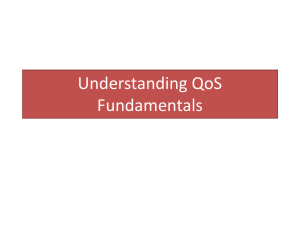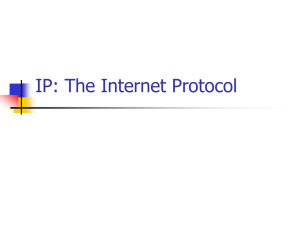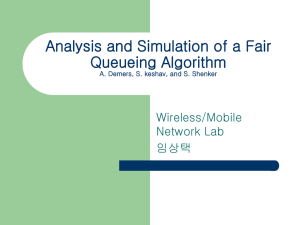Data Communications
advertisement
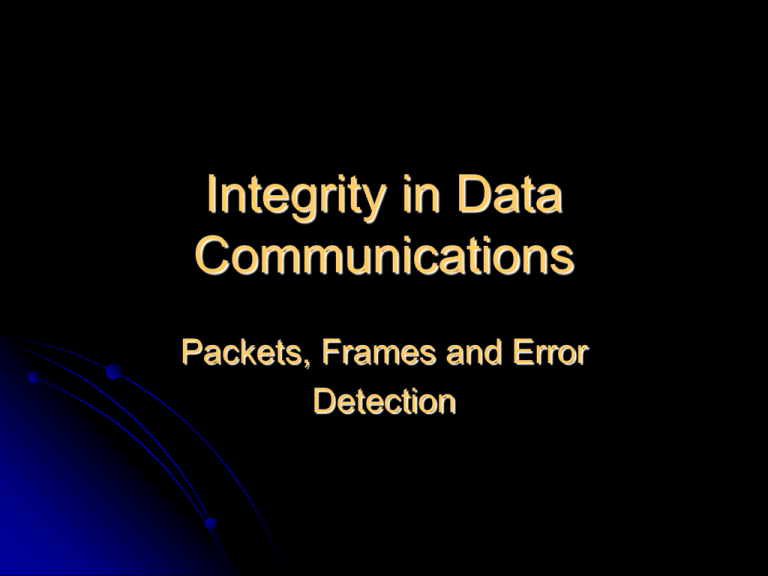
Integrity in Data Communications Packets, Frames and Error Detection More About Packets networks are called amounts of Networks do not These transfer arbitrary ‘packet networks’ or packet data for 2 reasons:switching networks’ 1. Errors in large blocks cause large delays. -Senders and receivers have to coordinate transmission. Errors often occur. -Dividing data into small blocks allows the sending and receiving computers to make fast retransmission. More About Packets 2. Computers have to share underlying connections in hardware. -Communications channels are expensive so sharing allows all to be treated equally. Early networks allowed an application to hold a resource until finished. Packets and Time-Division Multiplexing Computers take turns sending and receiving small packets of data. 1 Computer 1 using channel to send packet. 2 Multiplexing occurs here. 3 Packets and Time-Division Multiplexing Computers take turns sending and receiving small packets of data. 1 Computer 2 using channel to send packet. 2 Multiplexing occurs here. 3 Packets and Time-Division Multiplexing Computers take turns sending and receiving small packets of data. 1 Computer 3 using channel to send packet. 2 Multiplexing occurs here. 3 Packets and Time-Division Multiplexing Computers take turns sending and receiving small packets of data. A source with a small total amount will finish promptly. Larger amounts will take longer. Data are arriving at two or more computers simultaneously. Packets and Hardware Frames Packet = small block of data (General) Hardware technology defines size. Frame = term used for specific hardware ``packet``. Packets and Hardware Frames Packet = small block of data (General) Hardware technology defines size. Frame = term used for specific hardware ``packet``. soh block of data in frame eot Packets and Hardware Frames Packet = small block of data (General) Hardware technology defines size. Frame =Unprintable term used for specific hardware ASCII ``packet``. Characters soh Hex 01 block of data in frame eot Hex 04 Packets and Hardware Frames Packet = small block of data (General) Hardware technology defines size. Frame = term used for specific hardware ``packet``. Disadvantage is overhead. Advantage is reliability. Byte Stuffing Most networks cannot afford to reserve characters. Systems never confuse data with control information. So extra bits or bytes are inserted to change data for transmission. i.e. bit or byte stuffing The esc character is Hex 1B Byte Stuffing Character Characters in Data Sent ___________________________________ soh eot esc esc x esc y esc z Transmission Errors Parity Checking (RS 232) Checksums 16 bit checksums Break data into 16 bit (2byte) segments Sum the values Send the sum in with the transmission Receiver compares answers after transmission Transmission Errors Checksums H e l l o w o r l d . Transmission Errors Checksums H 48 e 65 l l o 6C 6C 6F 20 w o r 77 6F 72 l d . 6C 64 2E Transmission Errors Checksums H 48 e 65 l l o 6C 6C 6F 20 w o r 77 6F 72 l d . 6C 64 2E 4865 + 6C6C + 6F20 + 776F + 726C + 642E + carry = 71FC Ethernet Bus topology (10/100 Megabits) Gigabit Ethernet (Uses fibre as well) Hardware monitors bus for carrier No carrier – Sender transmits Carrier – sender waits Collisions Senders use a random number generator to calculate delay time If collision occurs again the range of the random number generator is increased. ATM Technology Designed for voice, video & data Voice and video require low delay and jitter Video also requires much higher data rate ATM Technology Packets should maximize payload 8 Kbytes is common in some networks Phone systems use an 8 bit audio sample every 125 microsecond (millionth of second) Sender must delay more than a second to accumulate enough samples to fill a packet Telephone systems employ echo cancellation techniques Large packets also create an echo problem ATM divides all data into fixed ``cells`` 48 octets for data 5 octets of header information ATM Technology Nortel has developed 6.4 Tbps Commercial platform of 6.4 Tbps was available in 2001. Uses Dense-wavelength division multiplexing. Designed to deliver 99.9999% reliability The End.
